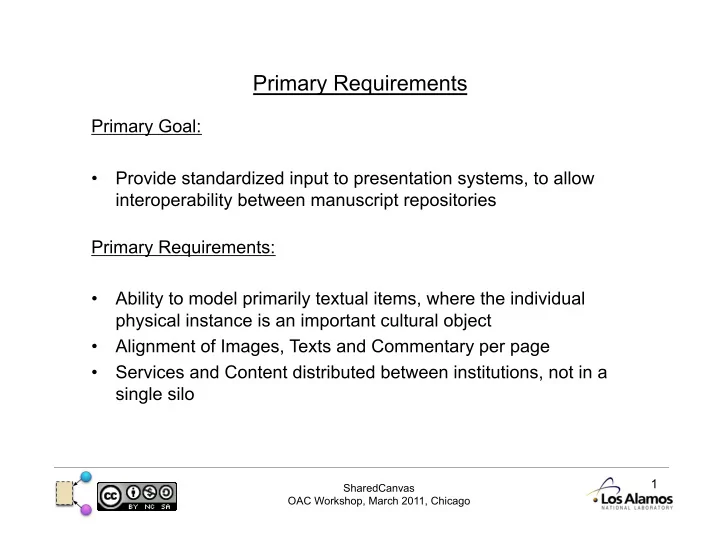

Primary Requirements Primary Goal: • Provide standardized input to presentation systems, to allow interoperability between manuscript repositories Primary Requirements: • Ability to model primarily textual items, where the individual physical instance is an important cultural object • Alignment of Images, Texts and Commentary per page • Services and Content distributed between institutions, not in a single silo 1 SharedCanvas OAC Workshop, March 2011, Chicago
Unique Requirements Working at the physical instance level provides unique requirements: • Only parts of pages may be digitized • Fragments of pages, only illuminations digitized, … • Or page may not be digitized at all • Would damage the page, already destroyed, hypothetical • Non-rectangular Pages: heart shaped manuscript • Aligning multiple Images that depict the same page • Spectral Imaging, Microfilm vs Photograph, Resolutions… • Order of Pages may be different over time due to rebinding • Pages may be physically held by different institutions 2 SharedCanvas OAC Workshop, March 2011, Chicago
Naïve Approach: Transcribe Images Directly But how to align multiple images, pages without images, fragments ??? 3 SharedCanvas OAC Workshop, March 2011, Chicago
Looking Around: Canvas Paradigm • A generic Canvas is an abstract space to build up a display • HTML5 • SVG • PDF • Our Canvas starts with no content, but has rectangular dimensions • Top left/bottom right corner of canvas is equivalent corner of page • Images and Text painted on to Canvas by distributed Annotation • The Image/Text/Commentary is the Annotation's Body • The Canvas is the Annotation's Target • Both Body and Target support Segment descriptions: • Fragments • Extract page/line text from full transcription 4 SharedCanvas OAC Workshop, March 2011, Chicago
SharedCanvas: Annotations to Paint Canvas 5 SharedCanvas OAC Workshop, March 2011, Chicago
Transcription via Canvas: M804 6 SharedCanvas OAC Workshop, March 2011, Chicago
Fragments: Cod Sang 1394 7 SharedCanvas OAC Workshop, March 2011, Chicago
Missing Pages: Parker CCC 286 8 SharedCanvas OAC Workshop, March 2011, Chicago
Order: Sequence and Range 9 SharedCanvas OAC Workshop, March 2011, Chicago
Rebinding: BNF f.fr. 113-116 10 SharedCanvas OAC Workshop, March 2011, Chicago
SharedCanvas: Data Model 11 SharedCanvas OAC Workshop, March 2011, Chicago
Summary • SharedCanvas uses OAC to model medieval manuscript layouts • Uses Canvas Paradigm with Annotations to paint content • Part of larger DMSTech Initiative • It can be used within a repository, or in a distributed collaboration • Enables and encourages participation • Ease of re-use 12 SharedCanvas OAC Workshop, March 2011, Chicago
Recommend
More recommend